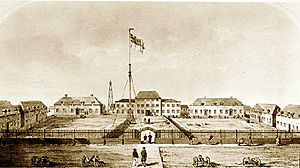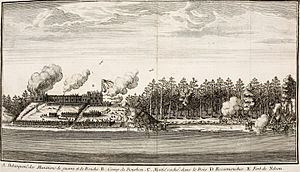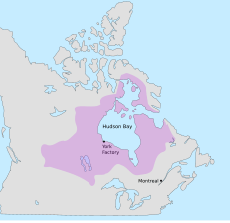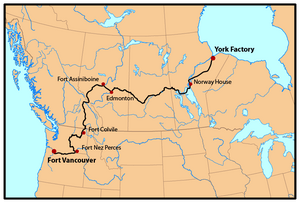York Factory facts for kids
Quick facts for kids York Factory |
|
|---|---|

York Factory in 1853
|
|
| Location | Manitoba, Canada |
| Area | 102 hectares (250 acres) |
| Founder | Hudson's Bay Company |
| Built | 1788 to 1850 |
| Original use | Fort, military structure, fur trading post |
| Governing body | Parks Canada |
| Designated | 1936 |
York Factory was an important trading post for the Hudson's Bay Company (HBC). It was located on the southwestern shore of Hudson Bay in northeastern Manitoba, Canada. You can find it at the mouth of the Hayes River, about 200 kilometers (124 miles) south-southeast of Churchill.
York Factory was one of the first fur-trading posts built by the HBC. It was started in 1684 and used for trading furs for over 270 years. From 1821 to 1873, it was the main office for the HBC's Northern Department. In 1936, it was named a National Historic Site of Canada.
The HBC closed York Factory in 1957. Since 1968, the Canadian government has owned it. Today, Parks Canada looks after the site. No one lives there all the time, but Parks Canada staff stay there in the summer. The main wooden building you see there today was built in 1831. It is the oldest and largest wooden building in Canada built on permafrost (ground that is always frozen).
Contents
Where is York Factory?
York Factory is on the north side of the Hayes River. It is about 7 miles (11 km) inland from the coast. The mouth of the Nelson River is to the north, across an area called "Point of Marsh." The Hayes River was better for canoes, even though the Nelson River is much bigger. Large ships had to anchor about 7 miles (11 km) from the fort because the water was too shallow. Smaller boats then carried goods to and from the fort. Today, the Shamattawa Airport and Gillam Airport are nearby.
A Look Back in Time
From the 1600s to the late 1800s, York Factory was a very important place. It was the main base for the Hudson's Bay Company's fur trade. The HBC traded with First Nations people across Rupert's Land. This huge area covered most of what is now Canada.
Early Days and Battles for the Fort
The first three HBC trading posts were set up around 1670. In 1684, the company built Fort Nelson near the mouth of the Nelson River. This was the first main office for the Hudson's Bay Company. They also built York Factory on the Hayes River, naming it after the Duke of York.
Building these forts made New France (French colonies in North America) upset. In 1686, French soldiers marched from Quebec and captured all the HBC posts. During King William's War, France sent ships to Hudson Bay many times to capture York Factory.
In 1694, a French leader named Pierre Le Moyne d'Iberville captured York Factory. He renamed it Fort Bourbon. But the English took it back the next year. In 1697, d'Iberville won a big naval battle in Hudson Bay. He then tricked the fort into surrendering by making it look like he had more soldiers. The French held York Factory until 1713. It was then given back to the British in the Treaty of Utrecht. York Factory became the main HBC office in the north again.
Building the Fort
From 1788 to 1795, the company built a new fort at York Factory. It was made of stone and brick and shaped like an octagon. But the stone and brick did not work well with the frozen ground (permafrost). So, in 1831, the stone fort was taken down. The main part of the wooden building you see today was finished that same year. The two side sections were added in the next two years.
Trading and Travel
For its first 100 years, York Factory worked by having First Nations traders come to the post. They would travel by canoe from far away rivers like the Saskatchewan and Red rivers.
Later, the North West Company became a strong competitor. Their traders, called voyageurs, traveled to the First Nations communities. To compete, the Hudson's Bay Company started sending its own traders out from York Factory. They built trading posts inland, even as far as the Oregon Country.
From 1821 to 1846, special groups called the York Factory Express traveled twice a year. They went overland to Fort Vancouver, which was the HBC's main office in the west. They carried supplies and trade goods there and brought furs back to London.
Changes and Closure
By the mid-1800s, York Factory was a large trading post with about 50 buildings. Most of these buildings are gone now. But it wasn't a very popular place to live. One chief trader, John McLean, said he was happy to leave York Factory's "fogs, and bogs and mosquitoes" in 1837.
York Factory's importance started to decline in the 1860s and 1870s. This was because Rupert's Land became part of Canada. Also, new ways of transport like railways and steamboats were used more. In 1872, York Factory only supplied a few posts in Manitoba. A year later, its role as the main fur trade office was given to Upper Fort Garry (which is now Winnipeg).
The post became even less important. From 1874 to 1875, it almost stopped receiving supplies. In 1911, York Factory briefly became the main office for a new district. But in 1929, that title moved to Churchill because a railway line connected Churchill to Winnipeg. After that, York Factory was just a local trading post.
In 1957, Hudson's Bay York Factory closed for good. The people who lived there moved to places like York Landing Cree Nation, Split Lake, and Shamattawa. Cree elders who lived at York Factory remembered wanting to stay at "Kihci-waskahikan" or "Great House" when it closed. These were names for the post used by the local Cree people.
Today, Parks Canada staff work at the historic site from June to mid-September. Since 1991, archaeologists have been digging to learn more about the old 18th-century "octagon" fort.
Images for kids







